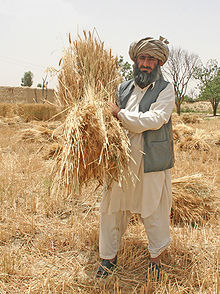Agriculture in Pakistan
Pakistan's principal natural resources are arable land and water. About 25% of Pakistan's total land area is under cultivation and is watered by one of the largest irrigation systems in the world. Agriculture accounts for about 23% of GDP and employs about 44% of the labor force. Pakistan is one of the world's largest producers and suppliers of the following according to the 2005 Food and Agriculture Organization of The United Nations and FAOSTAT given here with ranking:
- Chickpea (2nd)
- Apricot (4th)
- Cotton (4th)
- Sugarcane (4th) (National Juice of Pakistan)
- Milk (5th)
- Onion (5th)
- Date Palm (6th)
- Mango (7th) (National fruit of Pakistan)
- Tangerines, mandarin orange, clementine (8th)
- Rice (8th)
- Wheat (9th)
- Oranges (10th)


Pakistan ranks fifth in the Muslim world and twentieth worldwide in farm output. It is the world's fifth largest milk producer. Agriculture is the back bone of Pakistan's economy.[source?] Agriculture has also been the main source of population growth in Pakistan.[1]
References
change- ↑ Pakistan Agriculture. Finance Industry Publications. 1988.